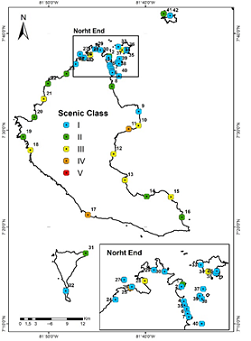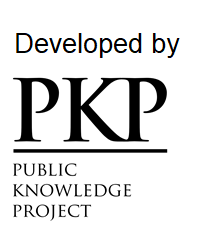First scenic assessment of the Coiba National Park’s beaches (Panama)
DOI:
https://doi.org/10.47193/mafis.37X2024010114Keywords:
Coastal scenery, remote beaches, Eastern Tropical Pacific, beach biodiversity, nature-based tourismAbstract
Coiba National Park (PNC) is one of the most important marine protected areas in the Americas, as an essential part of the Eastern Tropical Pacific Marine Corridor. As a marine protected area, its main objective is biodiversity conservation, although nature-based tourism and nautical activities are allowed. This research focused on the application of the Coastal Scenery Evaluation System (CSES) method along the entire PNC coastline. Based on two field visits, covering more than 200 km of coastline, 42 beaches were identified and evaluated, the vast majority in highly natural conditions. Similarly, five beaches were analyzed for biological data associated with the diversity of coastal fauna, as a preliminary inventory. The result of the CSES fuzzy logic calculation classified 64% of the beaches in the two highest scenery grades, with only 3 beaches in class IV, and none in class V. Regarding the biological data, macroinvertebrates were mostly represented by 13 mollusks, 1 echinoderm and 1 crustacean. In addition to scientific results, the research identified those beaches with the potential to be certified as coastal scenery of heritage value. In conclusion, this evaluation will help guide nature-based tourism actions within the PNC, and will serve as a baseline for future monitoring of the impact that tourism activity may have on beach fauna and natural attributes.
Downloads
Metrics
References
Botero CM, Cabrera JA, Cervantes OD, Pérez G. 2022. Certificação da paisagem de praias: o caso do EIC-PPP. In: Bombana B, Turra A, Polette M, editors. Gestão de praias: do conceito à prática. São Paulo: Instituto de Estudos Avançados da Universidade de São Paulo. p. 396-410. DOI: https://doi.org/10.11606/9786587773360
Brugnoli Olivera E, Molina L, Till I, Camarena M, Morales-Ramírez A, Díaz-Ferguson E. 2023. Mesozooplankton and oceanographic conditions in the North zone of Coiba National Park (Panamá, Central America). Reg Stud Mar Sci. 66: 103136.
Cristiano S, Rockett G, Portz LC, Rodrigues JL. 2020. Beach landscape management as a sustainable tourism resource in Fernando de Noronha Island (Brazil). Mar Pollut Bull. 150: 110621. DOI: https://doi.org/10.1016/j.marpolbul.2019.110621
Ergin A, Karaesmen E, Micallef A, Williams AT. 2004. A new methodology for evaluating coastal scenery: fuzzy logic systems. Area. 36: 367-386.
Garcés HA, Grimaldo M. 2005. Guía de laboratorio. Bio 330. Limnología general: parte biológica. Panamá: Departamento de Biología Marina y Limnología, Universidad de Panamá. 150 p.
Gómez Zuluaga CD. 2021. Evaluación paisajística de las playas en la Unidad Ambiental Costera (UAC) Urabá-Darién con el método CSES, mediante el diseño del ejecutable DproLitore en AppDesigner de MATLAB [thesis]. Turbo: Facultad de Ingeniería, Universidad de Antioquia. 100 p.
Guzmán HM, Beaver CE, Díaz-Ferguson E. 2021. Novel insights into the genetic population connectivity of transient whale sharks (Rhincodon typus) in Pacific Panama Provide crucial data for conservation efforts. Front Mar Sci. 8: 744109. DOI: https://doi.org/10.3389/fmars.2021.744109
Holme NA, McIntyre AD. 1984. Methods for the study of marine benthos. 2nd ed. IBP Handbook 16. Oxford: Blackwell Scientific Publications. 399 p.
Mestanza-Ramón C, Chica-Ruiz JA, Anfuso G, Mooser A, Botero CM, Pranzini E. 2020. Tourism in Continental Ecuador and the Galapagos Islands: an integrated coastal zone management (ICZM) perspective. Water. 12: 1647. DOI: https://doi.org/10.3390/w12061647
Mooser A, Anfuso G, Mestanza, C, Williams AT. 2018. Management implications for the most attractive scenic sites along the Andalusia coast (SW Spain). Sustainability. 10: 1328.
Rangel-Buitrago N, editor. 2019. Coastal scenery: evaluation and management. Dordrecht: Springer. 247 p.
Soto EH, Botero CM, Milanés CB, Rodríguez-Santiago A, Palacios-Moreno M, Díaz-Ferguson E, Velázquez YR, Abbehusen A, Guerra-Castro E, Simoes N, et al. 2021. How does the beach ecosystem change without tourists during COVID-19 lockdown? Biol Conserv. 255: 108972. DOI: https://doi.org/10.1016/j.biocon.2021.108972
West N. 2018. Beach use and behaviors. In: Finkl C, Makowski C, editors. Encyclopedia of Coastal Science. Encyclopedia of Earth Sciences Series. Cham: Springer. DOI: https://doi.org/10.1007/978-3-319-48657-4_43-2
Williams AT, Mooser A, Anfuso G, Herbert V, Aucelli P. 2023. Coastal scenic assessment in northern France: an attempt to quantify scenic beauty and analyse the role played by the Conservatoire du littoral. Ocean Coast Manage. 236: 106446. DOI: https://doi.org/10.1016/j.ocecoaman.2022.106446
Williams AT, Rangel-Buitrago NG, Pranzini E, Anfuso G, Botero C. 2018. Coastal scenery. In: Finkl C, Makowski C, editors. Encyclopedia of Coastal Science. Encyclopedia of Earth Sciences Series. Cham: Springer. DOI: https://doi.org/10.1007/978-3-319-48657-4_387-1

Published
How to Cite
Issue
Section
License
Copyright (c) 2024 Camilo M. Botero, Sara C. Justo, Humberto A. Garcés B., Edgardo Díaz-Ferguson

This work is licensed under a Creative Commons Attribution-NonCommercial-ShareAlike 4.0 International License.
Authors of articles published in Marine and Fishery Sciences retain copyright on their articles, except for any third-party images and other materials added by Marine and Fishery Sciences, which are subject to copyright of their respective owners. Authors are therefore free to disseminate and re-publish their articles, subject to any requirements of third-party copyright owners and subject to the original publication being fully cited. Visitors may also download and forward articles subject to the citation requirements. The ability to copy, download, forward or otherwise distribute any materials is always subject to any copyright notices displayed. Copyright notices must be displayed prominently and may not be obliterated, deleted or hidden, totally or partially.
This journal offers authors an Open Access policy. Users are allowed to read, download, copy, distribute, print, search, or link to the full texts of the articles, or use them for any other legal purpose within the Creative Commons 4.0 license (BY-NC-SA), without asking prior permission from the publisher or the author. This is in accordance with the BOAI definition of Open Access.




























